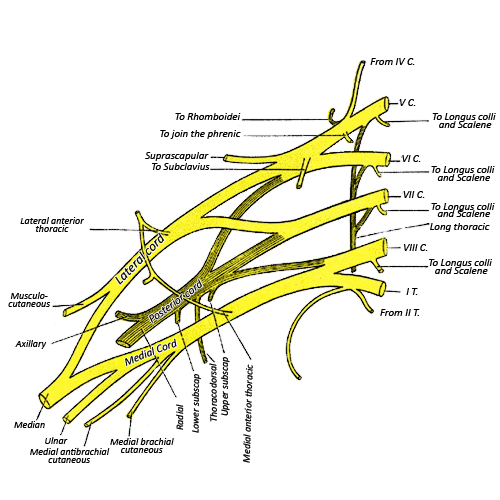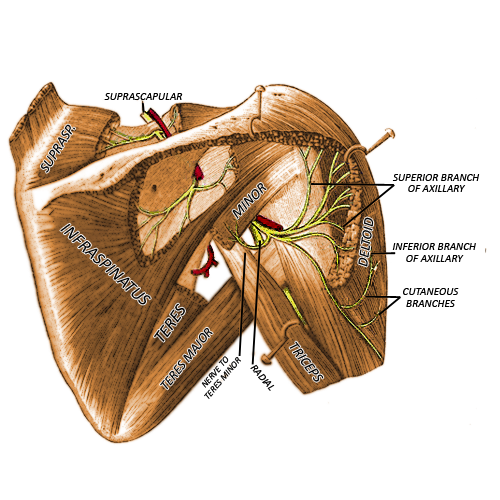Reading Time:
Overview
The axillary nerve is a terminal branch of the posterior cord of the brachial plexus. It has an important role in arm abduction and is of particular clinical interest due to its association with shoulder dislocations.
Gross Anatomy
The axillary nerve (C5, C6) is a terminal branch of the posterior cord of the brachial plexus. It initially lies behind the axillary artery and passes in front of the subscapularis muscle. It exits the axillary fossa posteriorly and passes through the quadrangular space.

The quadrangular space, illustrated below, transmits the posterior circumflex humeral artery and the axillary nerve. This space is bordered superiorly by teres minor, inferiorly by teres major, medially by the long head of triceps and laterally by the surgical neck of the humerus.

The nerve splits into anterior and posterior branches. The anterior branch passes around the surgical neck of the humerus and underneath the deltoid. It innervates the middle and anterior portions of the deltoid. The posterior branch supplies the teres minor as it passes underneath it and supplies the posterior deltoid. In addition it provides a collateral supply to the long head of triceps and a sensation to the glenohumeral joint. It terminates as the superior lateral cutaneous nerve of the arm which provides sensation to the "regimental badge" area over the lateral shoulder. This has important clinical relevance when assessing the integrity of the nerve.
Clinical Anatomy
Quick Anatomy
Key Facts
Origin
Terminal branch of posterior cord (C5-C6)
Motor function
Teres minor, deltoid, long head of triceps
Sensory function
Regimental badge region, glenohumeral joint
Aide-Memoire
Lorem ipsum dolor sit amet, sapien platea morbi dolor lacus nunc, nunc ullamcorper. Felis aliquet egestas vitae, nibh ante quis quis dolor sed mauris.
Summary
The axillary nerve is innervates the major abductor of the arm. It can be injured due to traction following dislocation or direct trauma following proximal humerus fractures. Appropriate clinical assessment is necessary in patients presenting with trauma to the shoulder and proximal arm.
References
Author; A Davies
